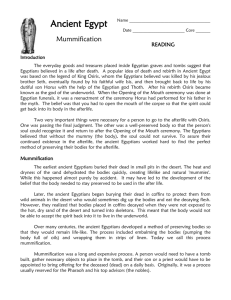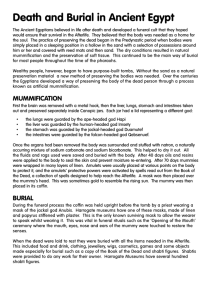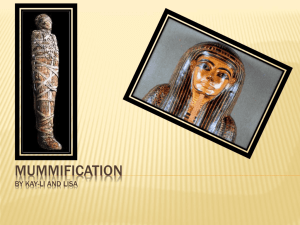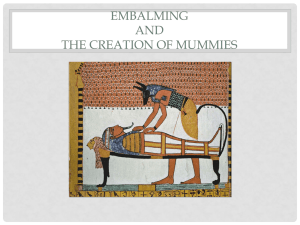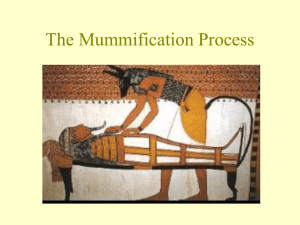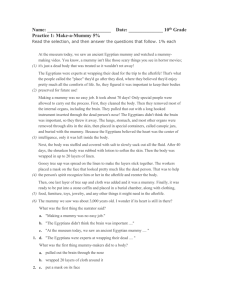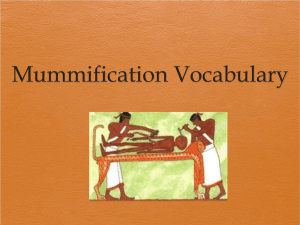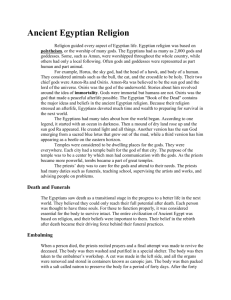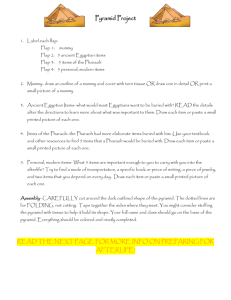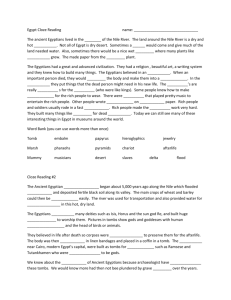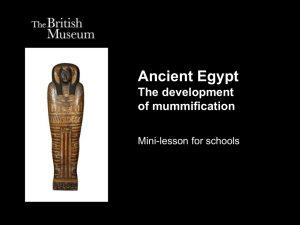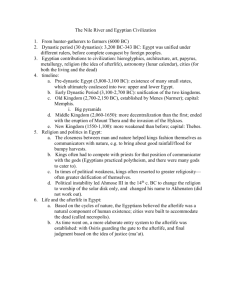Mummification
advertisement
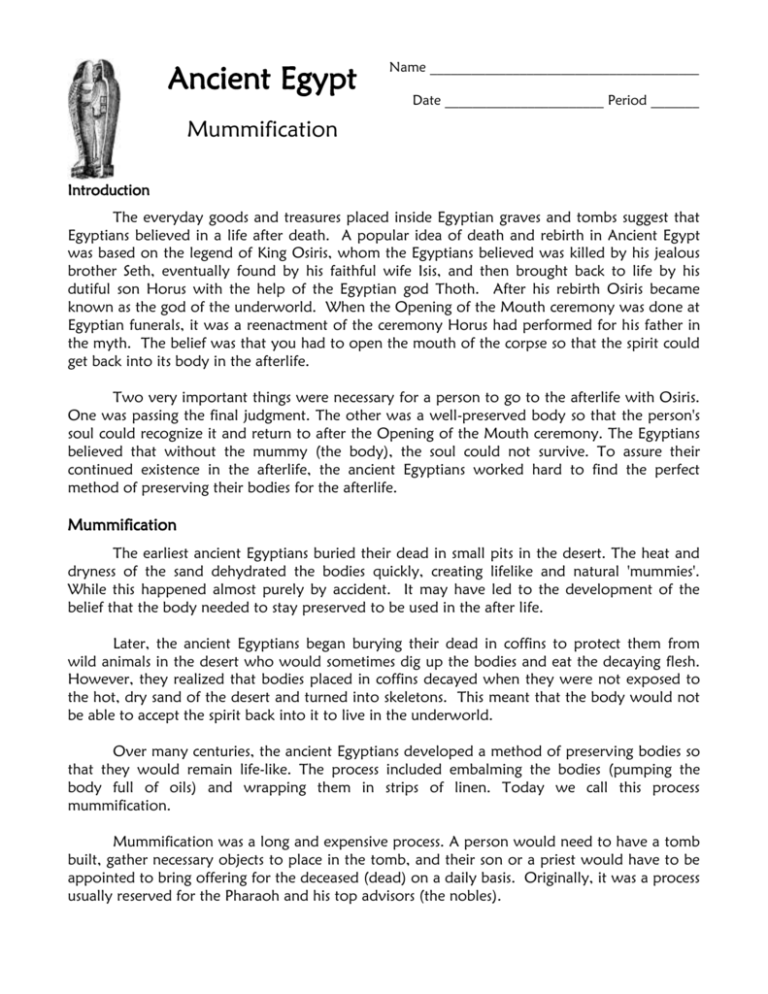
Ancient Egypt Name _______________________________________ Date _______________________ Period _______ Mummification Introduction The everyday goods and treasures placed inside Egyptian graves and tombs suggest that Egyptians believed in a life after death. A popular idea of death and rebirth in Ancient Egypt was based on the legend of King Osiris, whom the Egyptians believed was killed by his jealous brother Seth, eventually found by his faithful wife Isis, and then brought back to life by his dutiful son Horus with the help of the Egyptian god Thoth. After his rebirth Osiris became known as the god of the underworld. When the Opening of the Mouth ceremony was done at Egyptian funerals, it was a reenactment of the ceremony Horus had performed for his father in the myth. The belief was that you had to open the mouth of the corpse so that the spirit could get back into its body in the afterlife. Two very important things were necessary for a person to go to the afterlife with Osiris. One was passing the final judgment. The other was a well-preserved body so that the person's soul could recognize it and return to after the Opening of the Mouth ceremony. The Egyptians believed that without the mummy (the body), the soul could not survive. To assure their continued existence in the afterlife, the ancient Egyptians worked hard to find the perfect method of preserving their bodies for the afterlife. Mummification The earliest ancient Egyptians buried their dead in small pits in the desert. The heat and dryness of the sand dehydrated the bodies quickly, creating lifelike and natural 'mummies'. While this happened almost purely by accident. It may have led to the development of the belief that the body needed to stay preserved to be used in the after life. Later, the ancient Egyptians began burying their dead in coffins to protect them from wild animals in the desert who would sometimes dig up the bodies and eat the decaying flesh. However, they realized that bodies placed in coffins decayed when they were not exposed to the hot, dry sand of the desert and turned into skeletons. This meant that the body would not be able to accept the spirit back into it to live in the underworld. Over many centuries, the ancient Egyptians developed a method of preserving bodies so that they would remain life-like. The process included embalming the bodies (pumping the body full of oils) and wrapping them in strips of linen. Today we call this process mummification. Mummification was a long and expensive process. A person would need to have a tomb built, gather necessary objects to place in the tomb, and their son or a priest would have to be appointed to bring offering for the deceased (dead) on a daily basis. Originally, it was a process usually reserved for the Pharaoh and his top advisors (the nobles). But later, the Egyptians came to believe that anyone could go to the afterlife. The great cost of mummification, however, still limited the full procedure to only the rich people in the society. For the poor, a shallow grave near the desert was common and the hot and dry climate often caused natural mummification but at least there was still a chance that they could go to the afterlife. The Process of Mummification The first step in the mummification process was embalming the body. First, the body was taken to the tent known as 'ibu' or the 'place of purification'. There the embalmers washed the body with good-smelling palm wine and rinsed it with water from the Nile. Then, one of the embalmer's men made a cut in the left side of the body and removed many of the internal organs. It was important to remove these because they are the first part of the body to decompose or rot. The liver, lungs, stomach and intestines were washed and packed in natron, a special salt, which would dry them out. The heart was not taken out of the body because it was believed to be the center of intelligence and feeling and the man would need it in the afterlife. It needed to be carefully protected. On the other hand, a long hook was used to smash the brain and pull it out through the nose since Ancient Egyptians did not know what the brain was for and thought it was just stuffing or filling for the skull. Washing the body Removing the internal organs The body was now covered and stuffed with natron, which would dry it out. All of the fluids like blood and vile and rags from the embalming process would be saved and buried along with the body. After forty days the body was washed again with water from the Nile. Then it was covered with oils to help the skin stay elastic and life-like. The dehydrated internal organs were wrapped in linen and returned to the body. The body was stuffed with dry materials such Covering the body with natron (salts) as sawdust, leaves and linen to fill it back up so that it looked lifelike. Finally the body was covered again with good- smelling oils. It was now ready to be wrapped in linen. In the past, when the internal organs were removed from a body they were placed in hollow canopic jars. The animal on each jar was supposed to protect a different internal organ from harm. Over many years the embalming practices changed and embalmers began returning internal organs to bodies after the organs had been dried in natron. However, solid wood or stone canopic jars were still buried with the mummy to symbolically protect the internal organs. Canopic Jars After the body has been cleaned, dried and rubbed with good-smelling oils it was ready to be wrapped in linen. Wrapping the Mummy First the head and neck were wrapped with strips of fine linen. Then the fingers and the toes were individually wrapped (fig.1). The arms and legs were wrapped separately. Between the layers of wrapping, the embalmers placed amulets to protect the body in its journey through the underworld (fig.2). A priest read spells out loud while the mummy was being wrapped. These spells would help ward off evil spirits and help the deceased make the journey to the afterlife. Figure 1 The arms and legs were tied together. A papyrus scroll with spells from the Book of the Dead was placed between the wrapped hands (fig.3). Figure 2 More linen strips were wrapped around the body. At every layer, the bandages were painted with liquid resin that helped to glue the bandages together. A cloth was wrapped around the body and a picture of the god Osiris is painted on its surface (fig.4). Figure 3 Figure 4 Figure 5 Finally, a large cloth was wrapped around the entire mummy. It was attached with strips of linen that run from the top to the bottom of the mummy, and around its middle (fig.5). A board of painted wood was placed on top of the mummy before the mummy was lowered into its coffin. The first coffin was then put inside a second coffin. Then, the funeral was held for the deceased and his family mourned his death. A ritual called the 'Opening of the Mouth' was performed which would allow the person’s spirit to reenter the body. This also would allow the deceased to eat and drink again in the land of the dead. Finally, the body and its coffins were placed inside a large stone sarcophagus in the tomb. Furniture, clothing, valuable objects, food and drink were arranged in the tomb for the deceased. Now his body was ready for its journey through the underworld. There his heart would be judged by his good deeds on earth. If his heart is found to be pure he will be sent to live for all eternity in the beautiful 'Field of Reeds' with Osiris, god of the underworld. If his heart was found to be evil, he would be turned into a demon and be cursed to roam the earth in pain and sadness. Comprehsion Questions: Answer for homework, no complete sentences!! Early Burials 1. Why did the ancient Egyptians bury their dead in the desert and not near the Nile River? 2. Describe the early burials. What was the grave like? How was the person placed inside? What was buried with them and why? 3. How can mummies occur naturally? 4. How were burials improved to keep jackals away? Later Burials 5. How were the wealthy buried differently than poor people? 6. Why were these burials “disasters?” Why did the Egyptians mummify their dead? 7. Why did the ancient Egyptians believe that they needed to preserve a body? 8. What needed to recognize a body in order to find it? 9. What is “Ba” and “Ka?” How are they different? Mummification Process 10. How long does the entire mummification process take? 11. Where is it done? 12. How would the organs be removed? 13. Which four organs were preserved, wrapped, and placed in canopic jars? 14. Why did they do this? 15. Where is natron found? 16. How was the brain removed? Why was it thrown away? 17. Why was the heart left in the body? 18. What was used to wash the body and acted as an antiseptic, helping to kill bacteria? 19. Why is the “Eye of Horus” placed over the incision where the organs are removed? 20. What was inserted in the layers of bandages to further protect the mummy’s spirit on its way to the afterlife? 21. Why was resin used? Recognition 22. Why did the ancient Egyptians believe that the soul needed to recognize the body? 23. What could possibly destroy an afterlife? 24. Why was a mask placed over the wrapped mummy? 25. Why were “wedjat eyes” painted on the coffin? 26. Why was a sarcophagus used? Who used them? Spells and Ceremonies 27. What is the “Book of the Dead?” 28. Describe “The Weighing of the Heart” ceremony. 29. Describe “The Opening of the Mouth” ceremony.
